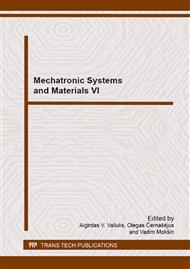[1]
D. Rodrigues, F.J.G. Landgraf, M. Emura, A. Flores Filho, L. Loureiro, L. Schaefer, Properties of iron powder for ac magnetic application, Key Eng. Mater. 189-191 (2001) 649–654.
DOI: 10.4028/www.scientific.net/kem.189-191.649
Google Scholar
[2]
H. Shokrollahi, K. Janghorban, Soft Magnetic Composite Materials (SMCs), J. Mater. Process. Technol. 189 (2007) 1–12.
DOI: 10.1016/j.jmatprotec.2007.02.034
Google Scholar
[3]
P. Kollár, J. Fűzer, R. Bureš, M. Fáberová, AC magnetic properties of Fe-based composite materials, IEEE Trans. Magn. 46 (2010) 467–470.
Google Scholar
[4]
B. Ślusarek, Powder magnetic materials, Przegl. Elektrot. (2010) 16–19.
Google Scholar
[5]
M. Najgebauer, J. Szczygłowski, Powder magnetic materials – technology, properties and applications, in: A. Krawczyk (Ed. ), Electromagnetism in environment – possibilities or danger?, Research-Scientific Institute ZTurek, Warsaw, 2010, Chapter 13, p.194.
Google Scholar
[6]
D.C. Jiles, D.L. Atherton, Theory of ferromagnetic hysteresis, J. Magn. Magn. Mater. 61 (1986) 48–60.
Google Scholar
[7]
J. Takács, Mathematics of the Hysteretic Phenomena, Wiley-VCH, Weinheim, (2003).
Google Scholar
[8]
G. Bertotti, I.D. Mayergoyz (Eds. ), The Science of Hysteresis, Academic Press, San Diego, (2005).
Google Scholar
[9]
K. Chwastek, Modelling magnetic properties of MnZn ferrites with the modified Jiles-Atherton description, J. Phys. D: Appl. Phys. 43(015005) (2010) 5 p.
DOI: 10.1088/0022-3727/43/1/015005
Google Scholar
[10]
K. Chwastek, J. Szczygłowski: The effect of anisotropy in the modified Jiles-Atherton model of static hysteresis, Arch. Elektr. Eng. 60 (2011), 49–57.
DOI: 10.2478/v10171-011-0005-8
Google Scholar
[11]
K. Chwastek, A dynamic extension to the Takács model, Physica B 405 (2010) 3800–3802.
DOI: 10.1016/j.physb.2010.06.003
Google Scholar
[12]
D. Gaworska, J. Koniarek, B. Węgliński, Influence of temperature on energy loss of dielectromagnetics, J. Magn. Magn. Mater. 304 (2006) e522–e524.
DOI: 10.1016/j.jmmm.2006.02.198
Google Scholar
[13]
Y.X. Pang, S.N.B. Hodgson, J. Koniarek, B. Węgliński, The influence of the dielectric on the properties of dielectromagnetic soft magnetic composites. Investigations with silica and silica hybrid sol-gel derived model dielectric, J. Magn. Magn. Mater. 310 (2007).
DOI: 10.1016/j.jmmm.2006.08.002
Google Scholar
[14]
H. Shokrollahi, K. Janghorban, The effect of compaction parameters and particle size on magnetic properties of iron-based alloys used in soft magnetic composites, Mater. Sci. Eng. B 134 (2006) 41–43.
DOI: 10.1016/j.mseb.2006.07.015
Google Scholar
[15]
M. Sablik, Modelling the effect of grain size and dislocation density on hysteretic magnetic properties in steels, J. Appl. Phys. 89 (2001) 5610–5613.
DOI: 10.1063/1.1359167
Google Scholar
[16]
N. C. Pop, O. F. Caltun, Jiles-Atherton magnetic hysteresis parameters identification, Acta Phys. Pol. A 120 (2011) 491–496.
DOI: 10.12693/aphyspola.120.491
Google Scholar
[17]
F. A. Sampaio da Silva, M. F. de Campos, A model for the hysteresis curves of soft magnetic materials, Mater. Sci. Forum 727–728 (2012) 130–134.
DOI: 10.4028/www.scientific.net/msf.727-728.130
Google Scholar
[18]
R. Szewczyk, J. Salach, A. Bieńkowski, P. Frydrych, A. Kolano-Burian, Application of extended Jiles-Atherton model for modeling the magnetic characteristics of Fe41. 5Co41. 5Nb3Cu1B13 alloy in as-quenched and nanocrystalline state, IEEE Trans. Magn. 48 (2012).
DOI: 10.1109/tmag.2011.2173562
Google Scholar
[19]
O. Messal, F. Sixdenier, L. Morel, N. Burais, Temperature dependent extension of the Jiles-Atherton model: study of the variation of microstructural hysteresis parameters, IEEE Transactions on Magnetics 48 (2012) 2567–2572.
DOI: 10.1109/tmag.2012.2201735
Google Scholar
[20]
B. Vaseghi, S.A. Rahman, A.M. Knight, Influence of steel manufacturing on J-A model parameters and magnetic properties, IEEE Trans. Magn. 49 (2013) 1961–(1964).
DOI: 10.1109/tmag.2013.2242054
Google Scholar
[21]
S. E. Zirka, Yu. I. Moroz, R. G. Harrison, K. Chwastek, On physical aspects of the Jiles-Atherton models, Journal of Applied Physics 112(043916) (2012) 7 p.
DOI: 10.1063/1.4747915
Google Scholar
[22]
D. Lederer, H. Igarashi, A. Kost, T. Honma, On the parameter identification and application of the Jiles-Atherton hysteresis model for numerical modelling of measured characteristics, IEEE Trans. Magn. 35 (1999) 1211–1214.
DOI: 10.1109/20.767167
Google Scholar
[23]
K. Chwastek, J. Szczygłowski, An alternative method to estimate the parameters of Jiles-Atherton model, J. Magn. Magn. Mater. 314 (2007) 47–51.
DOI: 10.1016/j.jmmm.2007.02.157
Google Scholar
[24]
A. Benabou, J.V. Leite, S. Clénet, C. Simão, N. Sadowski, Minor loop modelling with a modified Jiles-Atherton model and comparison with the Preisach model, J. Magn. Magn. Mater. 320 (2008) e1034–e1038.
DOI: 10.1016/j.jmmm.2008.04.092
Google Scholar
[25]
D. Miljavec, B. Zidarič, Introducing a domain flexing function in the Jiles-Atherton hysteresis model, J. Magn. Magn. Mater. 320 (2008) 763–768.
DOI: 10.1016/j.jmmm.2007.08.016
Google Scholar
[26]
G. Kádár, Z. Szabó, Magnetization process as a combined function of field and temperature in the product model of hysteresis, J. Magn. Magn. Mater. 272-276 (2004) e547–e549.
DOI: 10.1016/j.jmmm.2003.11.308
Google Scholar
[27]
Höganäs AB, Sweden, information on http: /www. hoganas. com.
Google Scholar
[28]
D. E. Finkel, Global optimization with the DIRECT algorithm: PhD Thesis, North Carolina State University, Raleigh, (2005).
Google Scholar
[29]
D. R. Jones, C. D. Perttunen, B. E. Stuckman, Lipschitzian optimization without the Lipschitz constant, J. Opt. Theor. Appl. 79 (1993) 157–181.
DOI: 10.1007/bf00941892
Google Scholar
[30]
J. Žilinskas, Branch and bound with simplicial partitions for global optimization, Math. Model. Anal. 13 (2008) 145–159.
DOI: 10.3846/1392-6292.2008.13.145-159
Google Scholar
[31]
R. Paulavičius, J. Žilinskas, A. Grothey, Investigation of selection strategies in branch and bound algorithm with simplicial partitions and combination of Lipschitz bounds, Optim. Lett. 4 (2010) 173–183.
DOI: 10.1007/s11590-009-0156-3
Google Scholar
[32]
R. -A. Naghizadeh, B. Vahidi, S. H. Hosseinian, Parameter identification of Jiles-Atherton model using SFLA, COMPEL 31 (2012) 1293–1309.
DOI: 10.1108/03321641211227573
Google Scholar


